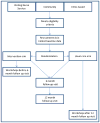Peer education for secondary stroke prevention in inner-city minorities: design and methods of the prevent recurrence of all inner-city strokes through education randomized controlled trial
- PMID: 22710563
- PMCID: PMC3408803
- DOI: 10.1016/j.cct.2012.06.003
Peer education for secondary stroke prevention in inner-city minorities: design and methods of the prevent recurrence of all inner-city strokes through education randomized controlled trial
Abstract
Background: The highest risk for stroke is among survivors of strokes or transient ischemic attacks (TIA). However, use of proven-effective cardiovascular medications to control stroke risk is suboptimal, particularly among the Black and Latino populations disproportionately impacted by stroke.
Methods: A partnership of Harlem and Bronx community representatives, stroke survivors, researchers, clinicians, outreach workers and patient educators used community-based participatory research to conceive and develop the Prevent Recurrence of All Inner-city Strokes through Education (PRAISE) trial. Using data from focus groups with stroke survivors, they tailored a peer-led, community-based chronic disease self-management program to address stroke risk factors. PRAISE will test, in a randomized controlled trial, whether this stroke education intervention improves blood pressure control and a composite outcome of blood pressure control, lipid control, and use of antithrombotic medications.
Results: Of the 582 survivors of stroke and TIA enrolled thus far, 81% are Black or Latino and 56% have an annual income less than $15,000. Many (33%) do not have blood pressures in the target range, and most (66%) do not have control of all three major stroke risk factors.
Conclusions: Rates of stroke recurrence risk factors remain suboptimal in the high risk, urban, predominantly minority communities studied. With a community-partnered approach, PRAISE has recruited a large number of stroke and TIA survivors to date, and may prove successful in engaging those at highest risk for stroke and reducing disparities in stroke outcomes in inner-city communities.
Copyright © 2012 Elsevier Inc. All rights reserved.
Figures
References
-
- Furie KL, Kasner SE, Adams RJ, Albers GW, Bush RL, Fagan SC, et al. Guidelines for the prevention of stroke in patients with stroke or transient ischemic attack: A guideline for healthcare professionals from the American Heart Association/American Stroke Association. Stroke. 2011 Jan;42(1):227–76. - PubMed
-
- Feinberg WM, Albers GW, Barnett HJ, Biller J, Caplan LR, Carter LP, et al. Guidelines for the management of transient ischemic attacks. From the ad hoc committee on guidelines for the management of transient ischemic attacks of the Stroke Council of the American Heart Association. Circulation. 1994 Jun;89(6):2950–65. - PubMed
-
- Burn J, Dennis M, Bamford J, Sandercock P, Wade D, Warlow C. Long-term risk of recurrent stroke after a first-ever stroke. The Oxfordshire community stroke project. Stroke. 1994 Feb;25(2):333–7. - PubMed
-
- Sacco RL, Shi T, Zamanillo MC, Kargman DE. Predictors of mortality and recurrence after hospitalized cerebral infarction in an urban community: The Northern Manhattan stroke study. Neurology. 1994 Apr;44(4):626–34. - PubMed
Publication types
MeSH terms
Substances
Grants and funding
LinkOut - more resources
Full Text Sources
Medical


